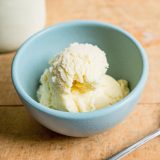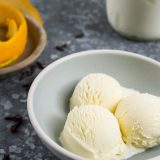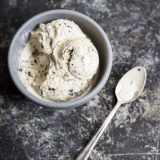Homemade ice cream has two problems. First, you need an ice cream machine. Don’t let anyone tell you that you can make good ice cream without one. You can’t. We’ve tried. (Plus, the machines are cheap and relatively compact.)
Second, it tastes creamy just after it’s made and only then. As soon as it goes in the freezer, it gets icy. And forget about the next day.
If someone could create a simple ice cream recipe that remains rich and creamy even after a stay in the freezer, I would be intrigued. A top-notch ice cream, flavored in any number of ways, is an easy, go-to dessert.
Sugar and fat make creamier ice cream, but it’s a tricky balance—too much of either produces a saccharine, tongue-coating dessert. The faster one freezes the ice cream, the better; speed produces smaller ice crystals. And ingredients that lower the freezing point of water, such as corn syrup, reduce crystallization.
Finding the right recipe turned out to be easier than I thought. I am a fan of Travis Lett’s Gjelina restaurant in Venice, California. His cookbook of the same name contains a recipe for a ginger-flavored gelato that uses milk, heavy cream, eggs and crème fraîche. The ginger is steeped in the dairy, then the mixture is thrown into a blender and strained. Unusually, the eggs and dairy are not cooked into a crème anglaise base (the eggs are effectively raw). The texture is incredible—creamy to a fault yet not over-the-top. Had Lett stumbled onto the perfect ratio of dairy fat, sugar and water, or was there a deeper mystery?
We started with the “Gjelina” recipe: vanilla, whole milk, heavy cream, eggs, crème fraîche, sugar and honey. After trying a dozen combinations, we made a few adjustments. We swapped out the milk-cream blend for half-and-half, doubled the crème fraîche, reduced the sugar and upped the honey. Like corn syrup, honey lowers the freezing point of water, producing smaller ice crystals (and therefore smoother ice cream).
Alcohol has an exceedingly low freezing point, allowing it to interact with the protein and fat in ice cream even when other ingredients have frozen. This gave us a more stable emulsion of fat and protein, which translates to a smooth, creamy texture.
In the course of our testing, I discovered there was more science at play. The bacteria used to produce crème fraîche secrete polysaccharides (long carbohydrate molecules) that act as stabilizers, much like vegetable gums, common additions to commercial ice cream. These molecules lower the freezing point of water as well. Crème fraîche contains 25 to 30 percent more carbohydrates by weight than heavy cream. So, it was the polysaccharides in the crème fraîche itself that made a difference—not just the ratio of ingredients.
Be sure to completely chill the mixture before transferring to an ice cream machine—the colder the better. This will speed the freezing process and produce smaller ice crystals. Also, be sure to freeze the container that you will store the ice cream in. Otherwise, a warm bowl will immediately melt some of your frozen dessert, which later will refreeze and turn icy.
You can easily create your own flavor variations. We offer orange-clove and chocolate-candied ginger. But go wild—the world is a lot bigger than just vanilla and chocolate.






